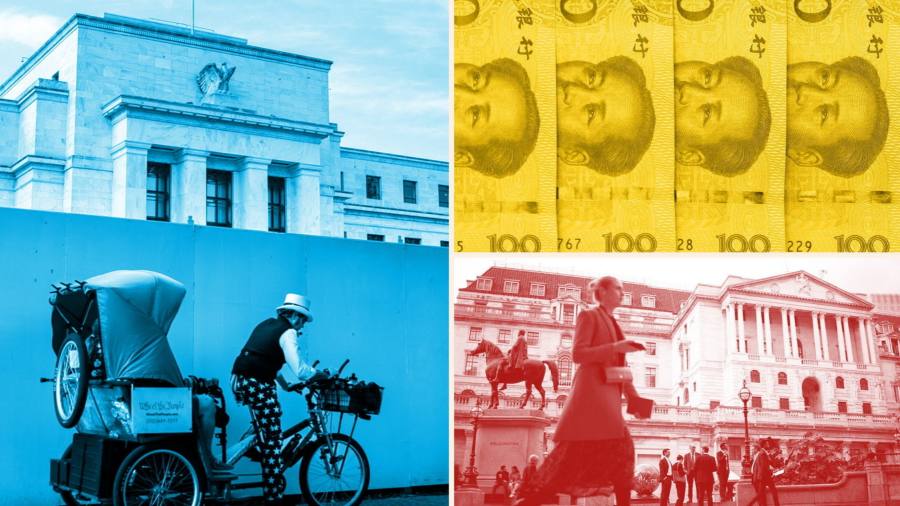Will the US yield curve invert further?
The gap between short- and long-term US government borrowing costs this week reached its widest point since the banking turmoil in March, a spread which may widen further next week as investors coalesce around the view that the Federal Reserve will keep interest rates higher for longer.
The US yield curve — which measures the difference between two- and 10-year Treasury yields — reached a three-month low on Friday of minus 97 basis points. This pattern, known as an inverted yield curve, is closely watched because it has preceded every US recession in the past 50 years. The curve has been inverted since last year.
Two-year yields move with interest rate expectations, while 10-year yields move with growth and inflation. So when investors see higher interest rates crushing economic growth, the yield curve inverts. The depth of an inversion does not indicate the severity or length of a recession, but it does suggest increasing conviction in the market that the Fed’s rate-hiking will hamper economic growth.
The inversion has deepened this week, and is likely to deepen further, after the Fed on Wednesday signalled its willingness to raise interest rates another two times this year, even as it paused its hiking cycle in June. The bank’s “dot plot” showed that most officials expected interest rates to be at 5.6 per cent by the end of the year, up from the current range of 5 to 5.25 per cent.
The Fed’s hawkishness this week forced investors, who have long bet that the central bank would cut interest rates by year-end, to remove those bets. Kate Duguid
What will the Bank of England do to tame inflation?
Markets are bracing for another busy week in the UK, with May’s inflation data on Wednesday ahead of the Bank of England’s next rate decision on Thursday and retail sales figures on Friday.
Annual price growth is expected to have eased to 8.5 per cent for the year to May, according to economists polled by Reuters, a touch lower than the rise of 8.7 per cent in April. Markets will be closely watching the level of core inflation — which strips out volatile food and energy prices — after it unexpectedly surged to 6.8 per cent last month.
Economists at Pantheon Macroeconomics predict that headline inflation in May will have dropped in line with consensus estimates, driven mainly by easing non-core fuel and food prices, while they expect a surge in service inflation driven by transport costs.
Markets have recently been considering the possibility of the BoE’s monetary policy committee raising the benchmark rate by 50 basis points next week, after stronger than expected wages data shocked the market last week, pushing two-year government bond yields to their highest level since 2008.
But consensus still rests on a 0.25 percentage point rise to 4.75 per cent. Futures markets are pricing in at least three further rate rises this year, peaking at 5.73 per cent by the end of December. Mary McDougall
Will China’s benchmark interest rate fall next week?
The People’s Bank of China (PBoC) cut both the seven-day reverse repo rate and the one-year medium term lending facility (MLF) rate by 0.1 percentage points this week. Economists are now forecasting an equivalent fall for the country’s one-year loan prime rate (LPR), which serves as the country’s benchmark interest rate.
The LPR is not set by the central bank but is calculated by adding the MLF rate to a spread based on the loans extended by China’s largest banks to their best customers — and normally a cut in the MLF is followed by an equivalent move for the LPR.
However, the PBoC can also pressure banks to lower the cost of lending even more through so-called “window guidance” behind the scenes.
Despite this possibility, analysts at Goldman Sachs are forecasting only a 0.1 percentage point reduction for the one-year LPR, as well as the five-year LPR, on June 20. Instead of a bigger cut, they argue that “a combination of monetary policy easing and fiscal policy support could be more effective to support overall economic growth”.
“The reduction in interest rates could set the stage for additional fiscal support and property easing in coming months, should growth remain disappointing,” they added.
However, widespread expectations for a 0.1 percentage point drop and broad disappointment with the expectation of policy support from Beijing so far this year mean that a bigger fall in the LPRs could easily spark a rally for Chinese equities. Hudson Lockett
Read the full article here



